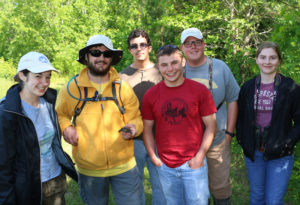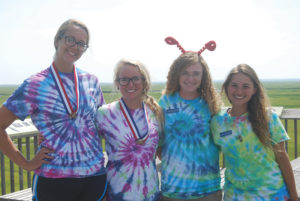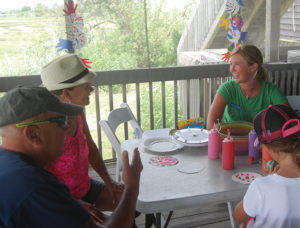Coastal Conservation Research Program

Our Coastal Conservation Research Program Interns spent 10 weeks this summer immersed in our projects, and creating their own projects. After acclimating to life in the saltmarsh, nights on bayshore beaches, and days on terrapin road patrols, each intern crafted and conducted their own independent research project. In the process, they gained personal experience navigating the small victories and temporary setbacks of field work, contributed to our ongoing projects, experienced the amazing places, people, and wildlife of southern New Jersey, and made friends along the way. Quite a lot to fit into 10 short weeks!
Elliott Fackler (Bloomsburg University) compared egg viability of horseshoe crabs between saltmarsh and bayshore spawning locations. Aaron Mitchell (University of Southern Mississippi) examined the effect of species interactions on the behavior of American Oystercatchers during the breeding season. Lauren Seacrist (Lander University) studied movements of American Oystercatchers between saltmarsh and barrier island locations. Adeline Schlussel (St. Mary’s College of Maryland) investigated the response of diamondback terrapins and terrapin predators to the introduction of an artificial nesting site, or ‘terrapin garden’. Wolfgang Trumbauer (Widener University) estimated hatchling sex ratios of diamondback terrapins by measuring temperature in nest cavities. Patrick Williams (Stockton University) captured diamondback terrapins in local marsh creeks to examine changes in the population structure.
Environmental Education Program
 This summer, Environmental Education Interns spent 12 weeks leading public education programs and interacting with visitors, while braving the mud, bugs, salt water and sun to create the best visitor experience possible. They worked hard and developed the skills they need to continue their careers in the environmental education field. Each year, interns develop and implement an education project that is personally and/or institutionally beneficial. The development of individual projects assists them in honing skill sets that are essential to creating fundamentally successful programs or initiatives within the field of environmental education.
This summer, Environmental Education Interns spent 12 weeks leading public education programs and interacting with visitors, while braving the mud, bugs, salt water and sun to create the best visitor experience possible. They worked hard and developed the skills they need to continue their careers in the environmental education field. Each year, interns develop and implement an education project that is personally and/or institutionally beneficial. The development of individual projects assists them in honing skill sets that are essential to creating fundamentally successful programs or initiatives within the field of environmental education.
Alexis Arnold (Lock Haven University) developed a three-part thematic education unit on plants for our Nature Education for Homeschool Students and Teachers (NEHST) program and piloted one of her lessons at our Summer Nature Program Kids Can Grow Farm Market. Anna Caputo (Green Mountain College) wrote, directed and edited a conservation education web series consisting of three complete episodes for The Wetlands Institute’s You Tube channel. Emily Colombo (George Mason University) built and installed bat boxes on Institute grounds and created a complimentary set of educational materials to accompany the installation. Diana Moczula (Carleton University) conceptualized a new service learning program entitled Helping Hands and developed six related programs that will be incorporated into The Wetlands Institute’s weekly summer general admission programs.
Marketing and Communications Program
 The Marketing and Communications Department implemented a formal Internship program this summer. If you visited the Institute this summer, you might have had the opportunity to chat with our friendly Marketing and Communications Intern, Victoria Deever (Penn State University). Victoria spent her summer interviewing visitors about their experiences, where they are from and how they learned about the Institute. She is analyzing visitor demographic to help the Institute better target marketing and communications in the future.
The Marketing and Communications Department implemented a formal Internship program this summer. If you visited the Institute this summer, you might have had the opportunity to chat with our friendly Marketing and Communications Intern, Victoria Deever (Penn State University). Victoria spent her summer interviewing visitors about their experiences, where they are from and how they learned about the Institute. She is analyzing visitor demographic to help the Institute better target marketing and communications in the future.
